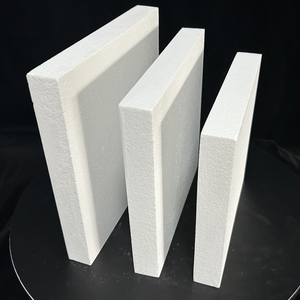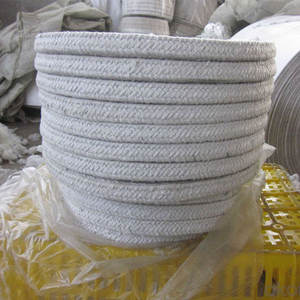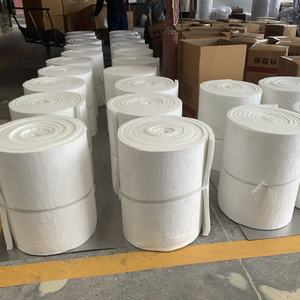Professional industry ceramic supplier, silicon nitride, silicon carbide, aluminum nitride and any other kinds of ceramics.
PRODUCT PARAMETERS
Description
Overview of Ceramic fiber blankets for 1260°C, 1400°C, and 1600°C. of various specifications for insulation fiber blankets.
Ceramic fiber blankets for 1260°C, 1400°C, and 1600°C. of various specifications for insulation fiber blankets. is a lightweight, high-temperature insulation material composed primarily of alumina-silica. It is manufactured through a melting and spinning or blowing process, resulting in a flexible, wool-like textile. This material is engineered to provide exceptional thermal management, conserving energy and protecting equipment in extreme temperature environments across various industries.
Features of Ceramic fiber blankets for 1260°C, 1400°C, and 1600°C. of various specifications for insulation fiber blankets.
-
Excellent Thermal Stability: Withstands continuous operating temperatures up to 1260°C (2300°F) and higher for certain grades, with minimal shrinkage.
-
Low Thermal Conductivity: Provides highly efficient insulation, reducing heat loss and improving energy efficiency.
-
Lightweight & Low Heat Storage: Offers low thermal mass, enabling rapid heat-up and cool-down cycles for improved process control and energy savings.
-
Thermal Shock Resistance: Highly resistant to damage from rapid temperature changes.
-
Excellent Flexibility & Resilience: Can be fabricated into blankets, boards, papers, and textiles to fit complex shapes and applications.
-
Good Chemical Stability: Resists attack from most corrosive agents, except strong alkalis and hydrofluoric acid.
Specification of Ceramic fiber blankets for 1260°C, 1400°C, and 1600°C. of various specifications for insulation fiber blankets.
Ceramic fiber coverings offer excellent high-temperature insulation. They are available in various grades to handle different warmth degrees. The 1260 ° C grade is an usual option. It takes care of temperatures up to 1260 degrees Celsius well. This covering is versatile and simple to mount. It is commonly utilized in furnaces and kilns. People additionally use it for central heating boiler insulation. Its regular density varieties from 96 to 128 kilos per cubic meter. Thicknesses are usually available from 12 to 50 millimeters. This material resists thermal shock successfully. It supplies great energy cost savings.
The 1400 ° C quality takes care of much more warm. It holds up against temperatures approximately 1400 levels Celsius. This makes it appropriate for hotter applications. It works well in high-temperature handling equipment. Foundries and petrochemical plants frequently use it. This blanket has a higher pureness level. Its thickness is typically between 96 and 192 kilos per cubic meter. Conventional densities mirror the 1260 ° C grade. It gives solid insulation performance. It also has good resistance to chemicals.
The 1600 ° C grade is the leading performer. It manages temperature levels reaching 1600 levels Celsius. This calls for unique zirconia content. It is optimal for extreme heat zones. Applications include aerospace and specialized heating systems. It is perfect for lining high-temperature vessels. This blanket has the highest possible density range. It often goes from 128 to 192 kilograms per cubic meter. Thickness choices remain similar to the others. It delivers exceptional thermal protection. Long-term stability is a vital benefit.
Applications of Ceramic fiber blankets for 1260°C, 1400°C, and 1600°C. of various specifications for insulation fiber blankets.
Ceramic fiber coverings supply trustworthy high-temperature insulation. Different grades manage details heat levels. Start with the 1260 ° C kind. This is common for several commercial tasks. Utilize it inside furnaces as lining material. It works well for boiler insulation as well. Safeguard heat-treating devices with it. This grade conserves energy effectively. It decreases heat loss considerably. Mount it around pipes lugging warm liquids. Use it for backup insulation behind firebrick. The covering is flexible and light. Setup is usually simple.
The 1400 ° C blanket takes on hotter areas. It suits kilns shooting ceramics or bricks. Apply it in reactors requiring continual high warm. This quality insulates commercial stoves extensively. It secures delicate devices from extreme temperatures. Utilize it where stronger insulation is compulsory. This covering endures more thermal tension. It remains stable under duplicated home heating cycles. Choose this for demanding procedure areas. Its greater thickness offers better efficiency. It manages direct fire exposure far better sometimes.
The 1600 ° C blanket is for severe conditions. It belongs in steelmaking and factory applications. Utilize it near molten steel get in touch with zones. It safeguards vital locations in glass manufacturing furnaces. This grade insulates high-temperature gas ducts. Use it where temperature levels increase suddenly. It withstands extremely extreme thermal shock. Chemical rust resistance is commonly superior. This blanket endures the toughest settings. It offers durable insulation where warm is fiercest.
Company Profile
Tanki New Materials Co.Ltd. focus on the research and development, production and sales of ceramic products, serving the electronics, ceramics, chemical and other industries. Since its establishment in 2015, the company has been committed to providing customers with the best products and services, and has become a leader in the industry through continuous technological innovation and strict quality management.
Our products includes but not limited to Aerogel, Aluminum Nitride, Aluminum Oxide, Boron Carbide, Boron Nitride, Ceramic Crucible, Ceramic Fiber, Quartz Product, Refractory Material, Silicon Carbide, Silicon Nitride, ect. please feel free to contact us.

Payment Methods
T/T, Western Union, Paypal, Credit Card etc.
Shipment Methods
By air, by sea, by express, as customers request.
5 FAQs of Ceramic fiber blankets for 1260°C, 1400°C, and 1600°C. of various specifications for insulation fiber blankets.
People ask many things about ceramic fiber blankets for high heat. Here are answers to common questions.
What temperatures do these blankets handle? Ceramic fiber blankets come in different grades. The 1260°C grade suits applications up to 1260 degrees Celsius. The 1400°C grade handles temperatures up to 1400 degrees. The 1600°C grade is for the highest heat, resisting temperatures up to 1600 degrees. Choose the grade matching your furnace or kiln’s peak temperature.
Are different thicknesses available? Yes. Blankets come in various thicknesses. Common options are 1/4 inch (6mm), 1/2 inch (12mm), 1 inch (25mm), and 2 inches (50mm). Thicker blankets provide better insulation. Thinner blankets are good for tight spaces. The right thickness depends on heat loss goals and space.
Where are these blankets typically used? People use them in many hot places. Examples include furnace linings, kiln insulation, boiler covers, and exhaust wrap. They work well for pipe insulation too. These blankets insulate equipment efficiently. They save energy.
How do you install these blankets? Installation is straightforward. Wear gloves and a mask. The fibers can irritate skin and lungs. Cut the blanket to size using sharp tools. Place it against the hot surface. Use special ceramic anchors or pins to hold it securely. You might need wire or high-temperature adhesive. Follow the manufacturer’s guide.
Are these blankets safe? Handle them carefully. The fibers are small. They can get airborne. Always wear protective gear when cutting or handling. Once installed, the blanket stays in place. It poses little risk. The blanket itself does not burn. It withstands very high heat safely.
REQUEST A QUOTE
RELATED PRODUCTS

Lightweight Ceramic Fiber Blanket Needlework.

Refractory Ceramic Fiber rope, heat-resistant Ceramic Fiber rope , Ceramic Fiber hemp rope

Ceramic fiber board in standard, high-aluminum, high-purity, and zirconium sizes available in custom sizes

2018 product kiln ceramic fiber board

High-quality Ceramic Fiber Cotton for industrial furnaces.



